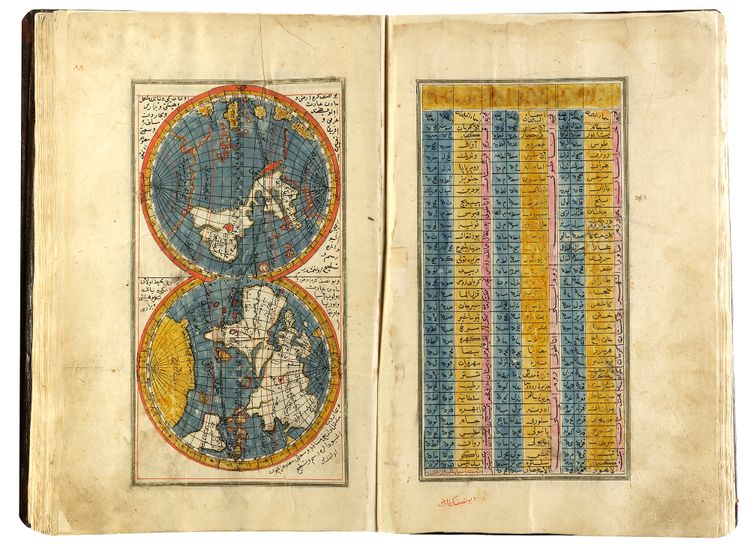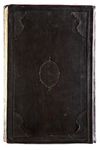MARIFETNAME, IBRAHIM HAKKI, COPIED BY SAE'D ALLAH BIN ALI BIN AHMED, TURKEY, 1221 AH/1806 AD
Arabic and Turkish manuscript on paper, 360 leaves plus 2 flyleaves, 35 lines to the page, written in neat naskh script in black ink, subheadings in red, margins ruled in black, red and gold, illuminated headpiece comprising foliate motifs in colors and gold, the manuscript comprising various colored maps, tables and charts, florally-illuminated colophon, 2 further illuminated headpieces, red morocco binding with gilt-stamped cartouches decorated with interlacing vines, with flap. Text panel: 12 by 23 cm. Book: 19 by 30 cm.
CATALOGUE NOTE The Marifetname is an encyclopedia of cosmological topics put together by Erzurumlu Ibrahim Haqqi in 1170 AH/1756-7 AD. The planispheric maps were drawn by Sae’d Allah bin Ali, and were based on the Dutch cartographer Joan Blae’s (d.1673) Atlas Major. Two further copies of Haqqi’s Ma’rifetnama, both dating from the first quarter of the nineteenth century, can be found in the British Library (MS.Or.12964) and Nasser D. Khalili Collection, London.
Marifetname is the second main work of Erzurumlu İbrahim Hakkı. The work includes a preface, three major chapters and an epilogue, each chapter is divided into subsections. The preface is entirely religious, the first part describes the existence and oneness of God, then describes simple and compound bodies, mines, plants and finally man. Then there are geometry, astronomy and calendar topics. It has shown the latitude and longitude of more than 100 provinces in the geography section. The second part includes sciences such as science, anatomy, and physiology. He also examined the human body in terms of aesthetics and squeezed couplets together. He believed in the relationship between body structure and temperament and explained this in poetry. At the end of this chapter, there is extensive information about the soul, health, and death. The third part with religious, divine and philosophical content. The last section about a method of teaching, the attitude of the student to his master, respect and love towards parents, qualifications to be sought in marriage and marriage, the custom of the relationship between husband and wife, duties towards children, the way of meeting and talking with relatives, servants, neighbors, friends, public and scholars, and its customs are included.





























